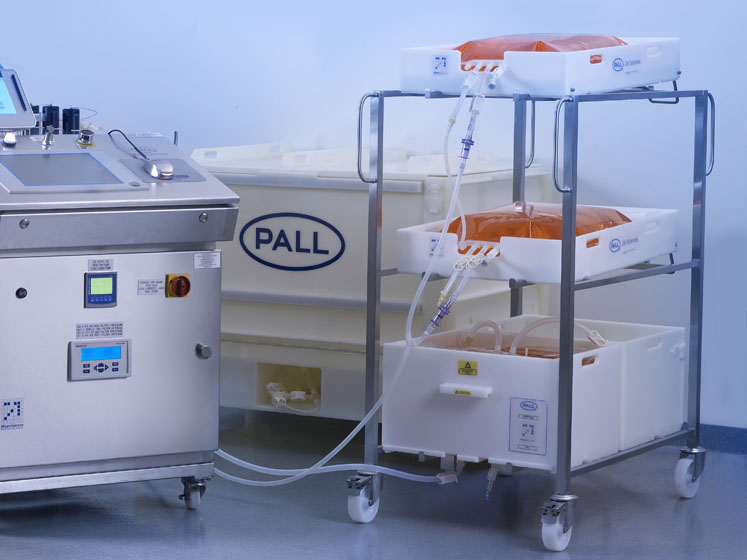Biopharmaceuticals represent a fundamental and growing component of the worldwide pharmaceutical market; the sector recorded global sales of $228 billion in 2016.1 This landscape will only become more challenging as cost pressures from healthcare systems increase and new competitors emerge; the battle for market share is on.
As a result, the biopharmaceutical industry is undergoing a paradigm shift from traditional batch processing to more advanced approaches such as continuous manufacturing.
It’s a move that regulators are on board with. When coupled with advanced automation, the small, fully enclosed processes — enabled by continuous methods — can increase productivity and reduce manual intervention, allowing companies to decrease inconsistencies that are introduced through human error. This benefit reduces waste, improves both yield and product quality, and increases profitability.
In a continuous process, there are upstream and downstream stages of production. The upstream process (USP) includes the bioprocessing phase in which biopharmaceuticals are generated and includes the initial harvest step(s) to give a clarified supernatant.
The downstream (DSP) is the phase that extracts or separates the desired products from the host and product-related impurities created during the USP. However, improvements in USP efficiency can have negative implications on the DSP, both in terms of processability and the higher titres afforded by upstream efficiencies causing downstream bottlenecks and facility fit issues.
Improvements in USP efficiency can have negative implications on the DSP, both in terms of processability and the higher titres afforded by upstream efficiencies causing downstream bottlenecks and facility fit issues
Downstream processes are also hindered by significant equipment changeover times between unit operations and equipment segregation for specific products or classes of biologic. This means that the downstream process for a biologic, including viral vectors, can take many days.
At Pall, our innovation and R&D has been heavily focused on evolving downstream processing from a stepwise batch operation to advanced manufacturing processes, such as continuous and single-use. Unlike single-use, continuous processes have to date not been widely adopted by industry.
Having successfully completed the development and implementation of downstream continuous processing at the bench, Pall is now focused on scaling this up for full-scale production. In partnership with Allergan, AstraZeneca, FujiFilm Diosynth, GSK, SCIEX and CPI, Pall is also working to address the technology gaps that are preventing widespread adoption.
Collaborating to find solutions
There are many analytical and automated technologies available … but there aren’t many that are specifically designed for the biopharma industry. Although several “off-the-shelf” continuous unit operations are available, these are not integrated into one complete solution and do not offer data to help companies fully assess the technical risks.2
The biopharma industry must develop its own technology. Pall Corporation, CPI, SCIEX and four other technology providers and biopharmaceutical companies with an interest in continuous manufacturing formed a consortium, funded by Innovate UK, to focus on three main deliverables.
The first is to develop a flexible automated biologics downstream purification platform consisting of multiple unit operations that can be rapidly reconfigured to manufacture different products.
The platform will be used to develop continuous DSPs for several biopharmaceuticals (including both monoclonal antibodies and an antibody fragment), increase efficiency and reduce the processing time to 25% of current run times, as well as significantly reduce capital, operation and material costs.

The system will need to connect unit operations of different types (including custom and legacy systems, as well as work with both batch and continuous unit operations), integrate with existing control software, automate system setup and shutdown, and lay the foundation for real-time release systems.
Development has also involved overcoming certain challenges, such as working across a variety of hardware and software interfaces and designing a flexible control system that can handle various processes (although the details will be unknown during the design phase and a multidisciplinary team will be needed to define the solution).
The consortium has developed an automated, integrated system that is being used to explore the practical challenges of converting established batch processes to continuous ones
The second goal will be to adapt up to three established batch processes to run on the continuous system while evaluating process performance and product quality. Lastly, the system will need to demonstrate one of the transferred processes at a clinically relevant scale.
To date, the consortium has developed an automated, integrated system that is being used to explore the practical challenges of converting established batch processes to continuous ones and represents a solid prototype on which to develop a preliminary commercial solution.
Where do we go from here?
There are clear benefits to a continuous approach, yet there are still challenges to overcome and efforts required to offer seamless continuous bioproduction throughout a process. Although the efforts of companies such as Pall and CPI will help to make the transition to a fully integrated end-to-end continuous process possible, they represent only one of many solutions required to overcome current hurdles.
We are in a critical moment in time. Biopharmaceuticals are now offering multiple therapies and treatment options for previously untreatable conditions, bringing hope to patients worldwide.
But, to overcome the challenges ahead, a concerted effort will be required from all parts of the industry. If we fail to mobilise and act, we will miss the opportunity to better serve patients and realise the full potential of biopharmaceuticals.
References
- E. Moorkens, et al., “The Market of Biopharmaceutical Medicines: A Snapshot of Diverse Industrial Landscape,” Frontiers in Pharmacology 8, 314: doi: 10.3389/fphar.2017.00314 (2017).
- https://franklin.ams3.cdn.digitaloceanspaces.com/content/images/Continuous-processing.pdf?mtime=20191106143228.
